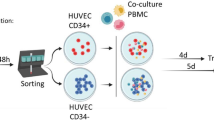We studied the effect of microvesicles derived from cells of the NK-92 cell line on the formation of tube-like structures by endothelial cells of the ЕА.Hy926 cell line. Microvesicles were isolated by differential centrifugation and their size was controlled by granulometric analysis using dynamic light scattering method. The effect of microvesicles produced by NK cells on angiogenesis was evaluated by cultural methods. In the course of the research, a model of co-culturing of microvesicles and endothelial cells on extracellular matrix Matrigel was developed. It was found that microvesicles derived from NK-92 cells promoted elongation of tube-like structures formed by endothelial ЕА.Hy926 cells. Microvesicles produced by NK cells can modulate functional activity of endothelial cells by affecting their ability to form blood vessels.
Similar content being viewed by others
References
Abhinand CS, Raju R, Soumya SJ, Arya PS, Sudhakaran PR. VEGF-A/VEGFR2 signaling network in endothelial cells relevant to angiogenesis. J. Cell Commun. Signal. 2016;10(4):347-354.
Aoki N, Yokoyama R, Asai N, Ohki M, Ohki Y, Kusubata K, Heissig B, Hattori K, Nakagawa Y, Matsuda T. Adipocytederived microvesicles are associated with multiple angiogenic factors and induce angiogenesis in vivo and in vitro. Endocrinology. 2010;151(6):2567-2576.
Bauvois B. New facets of matrix metalloproteinases MMP-2 and MMP-9 as cell surface transducers: outside-in signaling and relationship to tumor progression. Biochim. Biophys. Acta. 2012;1825(1):29-36.
Budaj M, Poljak Z, Ďuriš I, Kaško M, Imrich R, Kopáni M, Maruščáková L, Hulín I. Microparticles: a component of various diseases. Pol. Arch. Med. Wewn. 2012;122(Suppl 1):24-29.
Carmeliet P, Jain RK. Molecular mechanisms and clinical applications of angiogenesis. Nature. 2011;473:298-307.
Chen WS, Kitson RP, Goldfarb RH. Modulation of human NK cell lines by vascular endothelial growth factor and receptor VEGFR-1 (FLT-1). In Vivo. 2002;16(6):439-445.
Edsparr K, Johansson BR, Goldfarb RH, Basse PH, Nann-mark U, Speetjens FM, Kuppen PJ, Lennernäs B, Albertsson P. Human NK cell lines migrate differentially in vitro related to matrix interaction and MMP expression. Immunol. Cell Biol. 2009;87(6):489-495.
Jong AY, Wu CH, Li J, Sun J, Fabbri M, Wayne AS, Seeger RC. Large-scale isolation and cytotoxicity of extracellular vesicles derived from activated human natural killer cells. J. Extracell. Vesicles. 2017;6(1):1294368. doi: https://doi.org/10.1080/20013078.2017.1294368
Kalra H, Drummen GP, Mathivanan S. Focus on extracellular vesicles: introducing the next small big thing. Int. J. Mol. Sci. 2016;17(2):170. doi: https://doi.org/10.3390/ijms17020170
Kholia S, Ranghino A, Garnieri P, Lopatina T, Deregibus MC, Rispoli P, Brizzi MF, Camussi G. Extracellular vesicles as new players in angiogenesis. Vascul. Pharmacol. 2016;86:64-70.
Kim CW, Lee HM, Lee TH, Kang C, Kleinman HK, Gho YS. Extracellular membrane vesicles from tumor cells promote angiogenesis via sphingomyelin. Cancer Res. 2002;62(21):6312-6317.
Kleinman HK, Martin GR. Matrigel: basement membrane matrix with biological activity. Semin. Cancer Biol. 2005;15(5):378-386.
Leroyer AS, Rautou PE, Silvestre JS, Castier Y, Lesèche G, Devue C, Duriez M, Brandes RP, Lutgens E, Tedgui A, Boulanger CM. CD40 ligand+ microparticles from human atherosclerotic plaques stimulate endothelial proliferation and angiogenesis a potential mechanism for intraplaque neovascularization. J. Am. Coll. Cardiol. 2008;52(16):1302-1311.
Li J, Zhang Y, Liu Y, Dai X, Li W, Cai X, Yin Y, Wang Q, Xue Y, Wang C, Li D, Hou D, Jiang X, Zhang J, Zen K, Chen X, Zhang CY. Microvesicle-mediated transfer of microRNA-150 from monocytes to endothelial cells promotes angiogenesis. J. Biol. Chem. 2013;288(32):23,586-23,596.
Markova KL, Stepanova OI, Sheveleva AR, Kostin NA, Mikhailova VA, Selkov SA, Sokolov DI. Natural killer cell effects upon angiogenesis under conditions of contact-dependent and distant co-culturing with endothelial and trophoblast cells. Med. Immunol. (Rus). 2019;21(3):427-440.
Mostefai HA, Andriantsitohaina R, Martínez MC. Plasma membrane microparticles in angiogenesis: role in ischemic diseases and in cancer. Physiol. Res. 2008;57(3):311-320.
Papetti M, Herman IM. Mechanisms of normal and tumor- derived angiogenesis. Am. J. Physiol. Cell Physiol. 2002;282(5):C947-C970.
Ponce ML. Tube formation: an in vitro matrigel angiogenesis assay. Methods Mol. Biol. 2009;467:183-188.
Sadallah S, Eken C, Schifferli JA. Ectosomes as modulators of inflammation and immunity. Clin. Exp. Immunol. 2011;163(1):26-32.
Sedgwick AE, D’Souza-Schorey C. The biology of extracellular microvesicles. Traffic. 2018;19(5):319-327.
Simak J, Gelderman MP, Yu H, Wright V, Baird AE. Circulating endothelial microparticles in acute ischemic stroke: a link to severity, lesion volume and outcome. J. Thromb. Haemost. 2006;4(6):1296-1302.
Sokolov DI, Markova KL, Mikhailova VA, Vyazmina LP, Milyutina YuP, Kozyreva AR, Zhdanova AA, Malygina DA, Onokhin KV, Ivanova AN, Korenevsky AV, Selkov SA. Phenotypic and functional characteristics of microvesicles produced by natural killer cells. Med. Immunol. (Russ). 2019;21(4):669-688.
Soleti R, Martinez MC. Sonic Hedgehog on microparticles and neovascularization. Vitam. Horm. 2012;88:395-438.
Todorova D, Simoncini S, Lacroix R, Sabatier F, Dignat- George F. Extracellular vesicles in angiogenesis. Circ. Res. 2017;120(10):1658-1673.
Turu MM, Slevin M, Matou S, West D, Rodríguez C, Luque A, Grau-Olivares M, Badimon L, Martinez-Gonzalez J, Krupinski J. C-reactive protein exerts angiogenic effects on vascular endothelial cells and modulates associated signalling pathways and gene expression. BMC Cell Biol. 2008;9:47. doi: https://doi.org/10.1186/1471-2121-9-47
Udan RS, Culver JC, Dickinson ME. Understanding vascular development. Wiley Interdiscip. Rev. Dev. Biol. 2013;2(3):327-346.
van der Pol E, Coumans FA, Grootemaat AE, Gardiner C, Sargent IL, Harrison P, Sturk A, van Leeuwen TG, Nieuwland R. Particle size distribution of exosomes and microvesicles determined by transmission electron microscopy, flow cytometry, nanoparticle tracking analysis, and resistive pulse sensing. J. Thromb. Haemost. 2014;12(7):1182-1192.
Yang C, Mwaikambo BR, Zhu T, Gagnon C, Lafleur J, Seshadri S, Lachapelle P, Lavoie J.C, Chemtob S, Hardy P. Lymphocytic microparticles inhibit angiogenesis by stimulating oxidative stress and negatively regulating VEGF-induced pathways. Am. J. Physiol. Regul. Integr. Comp. Physiol. 2008;294(2):R467-R476.
Zhu L, Kalimuthu S, Gangadaran P, Oh JM, Lee HW, Baek SH, Jeong SY, Lee SW, Lee J, Ahn BC. Exosomes derived from natural killer cells exert therapeutic effect in melanoma. Theranostics. 2017;7(10):2732-2745.
Author information
Authors and Affiliations
Corresponding author
Additional information
Translated from Kletochnye Tekhnologii v Biologii i Meditsine, No. 3, pp. 164-169, September, 2020
Rights and permissions
About this article
Cite this article
Markova, K.L., Kozyreva, A.R., Sokolov, D.I. et al. Microvesicles Produced by Natural Killer Cells Regulate the Formation of Blood Vessels. Bull Exp Biol Med 170, 123–127 (2020). https://doi.org/10.1007/s10517-020-05017-y
Received:
Published:
Issue Date:
DOI: https://doi.org/10.1007/s10517-020-05017-y




